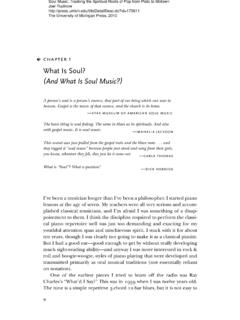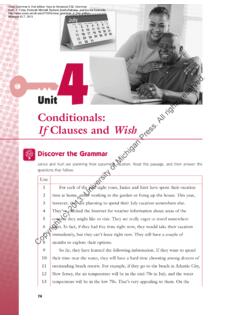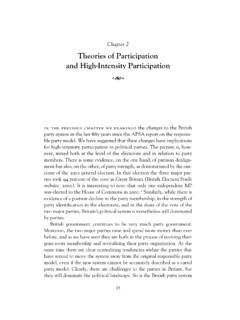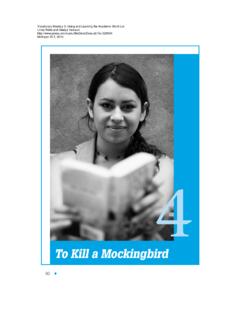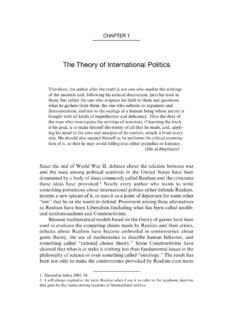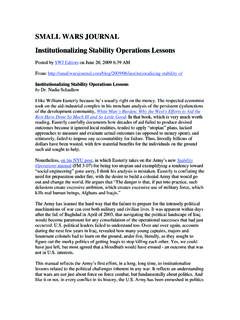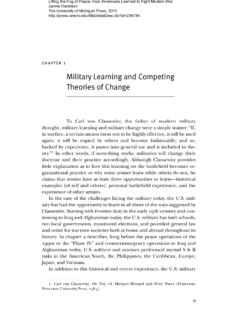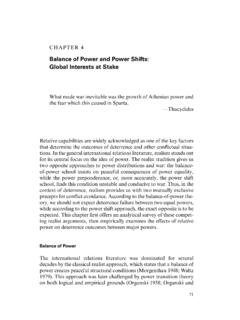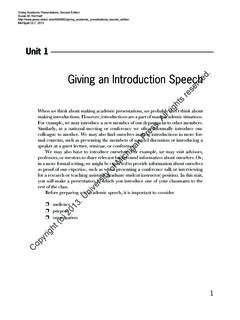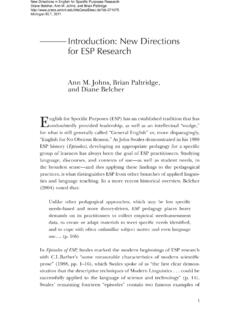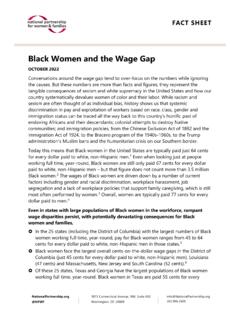Transcription of Chapter 2 Signifying Incest African-American Revisions
1 Chapter 2 Signifying IncestAfrican- american RevisionsAs we have already seen, the dominant nineteenth-century Incest story workedto construct the virtues of the white middle class, embodied in the strong patri-arch, in opposition to those whose narratives about Incest only con rmed theirimmorality: young girls, the poor, and racialized others who are understood tobe sexually deviant. The culturally dominant story, then, made it easy for theprosperous and white to understand Incest as a problem of the poor and way of understanding Incest is related to another similarly powerful anddeeply wounding narrative that has also found sexual aberration in blackfamilies, which are themselves described as aberrant. Maxine Baca Zinndescribes this narrative about the dysfunctional black family as based on a cul-tural-de ciency model, which, among other things, assigns the cause of thegrowing underclass to the structure of the family (72). So, to use the mostinfamous example, the 1965 Moynihan report focuses on the poor black fam-ily as at the center of the tangle of pathology with a weak family structure [afemale- headed family] now the principal source of most of the aberrant,inadequate, or antisocial behavior (Negro Family,30).
2 1 When family structurebecomes the cause of the economic and social marginality of poor black fami- lies , the more distant cause of slavery (and its aftermath) almost completelydisappears. As a result of this occluding of the past, the African-American fam-ily can be constructed as a place where the victims of slavery and racism areportrayed as their own victimizers. The idea that poor black families are doing it to themselves, so to speak,is incorporated into the metaphor of the incestuous black family, an inbredbreeding ground of deviant black men, too strong yet easily preyed-uponwomen, and illegitimate children. In telling the Incest story, an african -Amer-ican novelist always risks making the structure of the family rather than otherracialized structures in transition such as patterns of employment, educa-tional opportunities, provision of housing an isolated origin for the impov-erishment and violence in poor black communities, communities that areoften imagined in opposition to a fantasized white fact, illegitimacy31 Telling Incest : Narratives of Dangerous Remembering from Stein to Sapphire Janice Doane and Devon Hodges The University of Michigan Press, among white youths were, in 1965, rising very rapidly, a fact masked bythe Moynihan report s emphasis on black family deviance (D Emilio andFreedman, 300).
3 african -Americans, aware of the way the cultural de ciency modelblames the black family for what Hortense Spillers calls slavery s prescribedinternecine degradation, have sometimes felt that Incest in the black familycannot be discussed without con rming myths of black deviance. It may bebetter not to tell. This form of silence, silence as social discretion, is one thattacitly supports racialized, patriarchal prerogatives. (Ann duCille has recentlycalled this silencing the discourse of deference, female deference to the causeof a masculinist ideology of uplift [65].) The cultural de ciency modelinsists that the forms of patriarchal dominance historically enjoyed by whitemen (and described by feminists as a causeof abuse) would, when claimed byblack fathers, cureaberrant, because female - headed , African-American fami- lies . In other words, not telling ultimately functions to legitimize forms ofgendered inequality within the family that have been linked not only withincestuous abuse but with slavery, a white, paternalistic system in whichdependents were cared for and also sexually and economically it was precisely the discourse of paternalism, of caring, that allowedslave owners to understand their harsh abuse of slaves to be a form of benevo-lent, parental course, given especially high rates of black male unemployment andincarceration, it may seem particularly dif cult for black women to criticizepatterns of patriarchal dominance in the black community, no matter whattheir social and historical contexts.
4 As Melba Wilson, a black Incest survivorputs it, by talking about Incest , some may feel that I have breached an evengreater taboo, crossed a bigger boundary .. than Incest (1). For African-American novelists, telling similarly involves a complex racial and genderedpolitics that threatens to exact a real and familiar price: the further marginal-ization of African-American life and the exacerbation of tensions caused by thedifferent ways in which black men and women have experienced economic andsocial disenfranchisement. This Chapter will attempt to show how the African-American Incest novel negotiates the risk of saying the wrong thing, or saying the thing the wrong anxiety about the representation of blackness and concerns abouthow an Incest story will be understood by black as well as white audiences, African-American writers, perhaps because of a long tradition of resisting dis-cursive unfreedom by Signifying on dominant and excruciatingly painful cul-tural myths, have artfully told and revised the Incest story.
5 Indeed, they wereamong the rst writers courageous enough to substantially explore this Revisions have eventually made the Incest narrative available to manyother writers, such as white feminists, who use accounts of Incest to articulate32 Telling IncestTelling Incest : Narratives of Dangerous Remembering from Stein to Sapphire Janice Doane and Devon Hodges The University of Michigan Press, history of subjugation. African-American Incest narratives thus af rm Elli-son s law : First something happens to us; and then, just wait, it happens toevery other group in America (Fabre and O Meally, 4).4 Through African-American novels, the story of Incest begins to signify, in racial and gender-speci c ways, a once culturally unspeakable and horri c collective past thatmight, as Barbara Christian puts it, terrify readers by exposing the viciouspredations of a patriarchal, white culture (331). In other words, these texts shiftthe site of what is unspeakable from the marginal to the dominant contradictions and pain that are central to the African-American incestnovel are narrated from different perspectives as they become thinkable andsayable.
6 This Chapter will describe the changing contours of the silences inte-gral to this narrative by examining the mistakes (telling the wrong story ofincest or telling the story of Incest the wrong way) made in two well-knownnovels: Ralph Ellison s Invisible Man,Toni Morrison s The Bluest , which have been visibly woven into the text of public culture, usefullyhighlight the dangers and possibilities of narratives that offer to reveal secretsabout Incest in the African-American family. The African-American inceststory, precisely because of the way it explicitly operates as a narrative thatundoes boundaries and violates taboos, is a useful discursive strategy for open-ing up and reconceptualizing the dynamics of public power and privatespeechlessness. In African-American novels, this process of undoing cruciallyinvolves a blurring of the culturally sanctioned place given to a speaking sub-ject, usually a paternal gure, with the place of a devalued and objecti ed per-son: for example, Trueblood (Ellison s black male shareholder) and Pecola(Morrison s violated daughter).
7 Through the recon guration of the inceststory, what emerges is the formerly hidden perspective of a violated, objecti edperson into whom something unwanted has been put. This unwanted sub-stance a residue from a violent past and the seed of the future becomes thebasis of a new social subjectivity. The formerly dehumanized person, most dra-matically the Incest victim but to some extent the emasculated perpetrator aswell, becomes increasingly vocal as shifting social and political relations trans-form the constraints on what can be said and who can be heard. Indeed, theincest novel functions as a polemical and pedagogical device, one speci callyconcerned to understand how past histories are effaced and how these silencednarratives are recovered. This process is represented as having the power totransform the future, often gured in the possibility of new life, children result-ing from early instance of this kind of destabilizing telling of Incest occurs inRalph Ellison s Invisible Man,an immediately acclaimed best-seller that waspublished in 1952 as the civil rights movement was about to novelexplores and violates the rules governing who can claim the position of anauthoritative speaking subject in a segregated America.
8 For example, early inSignifying Incest33 Telling Incest : Narratives of Dangerous Remembering from Stein to Sapphire Janice Doane and Devon Hodges The University of Michigan Press, book, the narrator describes a traumatic memory of a battle royal, inwhich the town s leading white men sadistically entertain themselves by watch-ing blindfolded black schoolboys, including the narrator, ght each other. Yeteven while blinded and bombarded with punches, the narrator cannot stopworrying about whether or not he will be allowed to give the valedictory ora-tion that a school administrator has asked him to present to the same town dig-nitaries who are now terrorizing him. What is really important is the chance tospeak and be heard, even if the topic, social responsibility, is one sanctionedby hostile and culturally dominant whites who want to hear that humility wasthe secret, indeed, the very essence of progress (20). When, bleeding and fear-ful, the narrator nally gets to speak, his audience alternately taunts andignores him.
9 As the narrator explains his understanding of social responsibility, itbecomes clear that responsibility falls mainly upon blacks to understand thatthey live in the midst of plenitude and have but to cast their bucket into thiswell of possibilities to better themselves. This safe message succeeds in placat-ing, though just barely, his white audience, and the narrator must swallow hisown blood to go on speaking. Taunted to repeat the phrase social responsibil-ity one too many times, the narrator slips and substitutes the phrase socialequality. This verbal slip makes the white audience dangerously uncomfort-able and even more hostile. As Eric Sundquist points out, the phrase socialequality meant desegregation, which would seem to lead to racial mixing the right of blacks and whites to date, intermarry, and to have children (66).7 The narrator s mistake violates a taboo by suggesting an invitation to misce-genation, the prohibited sexual relations that secured the Jim Crow logic ofracial segregation.
10 Sexuality is an important register of the history of american race taboo on miscegenation, situated in proximity to Incest (another form ofprohibited sexual relations), functions to obscure the fact that it was primarilywhite men, who, by raping objecti ed dependents, were responsible forracial mixing. This inability to acknowledge that the sexual rule-makers are theprimary rule-breakers emerges in the language of a nineteenth-century South-ern sociologist, Henry Hughes:Impurity of races is against the law of nature. Mulattoes are monsters. Thelaw of nature is the law of God. The same law which forbids consanguinousamalgamation forbids ethnical amalgamation. Both are incestuous. Amal-gamation is Incest . (qtd. in Rogers, 166) This passage is extremely incoherent, but the gist of it, as David Rogers pointsout, is that the mulatto becomes the consequence of mixing qualities that are atonce too different, an ethnical amalgamation, and at the same time too much34 Telling IncestTelling Incest : Narratives of Dangerous Remembering from Stein to Sapphire Janice Doane and Devon Hodges The University of Michigan Press, and consanguinous.
